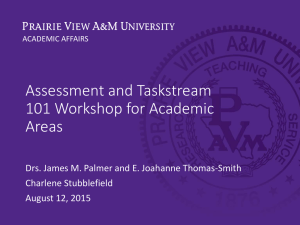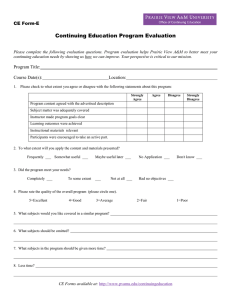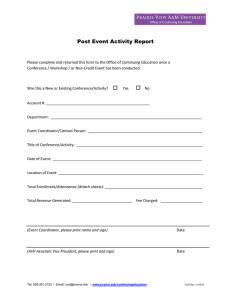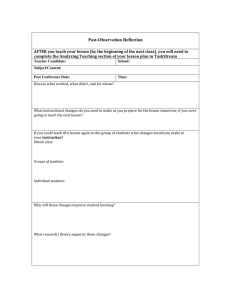Assessment and Taskstream 101 Workshop for Administrative Support, Student Support, Research, and Community/Public
advertisement
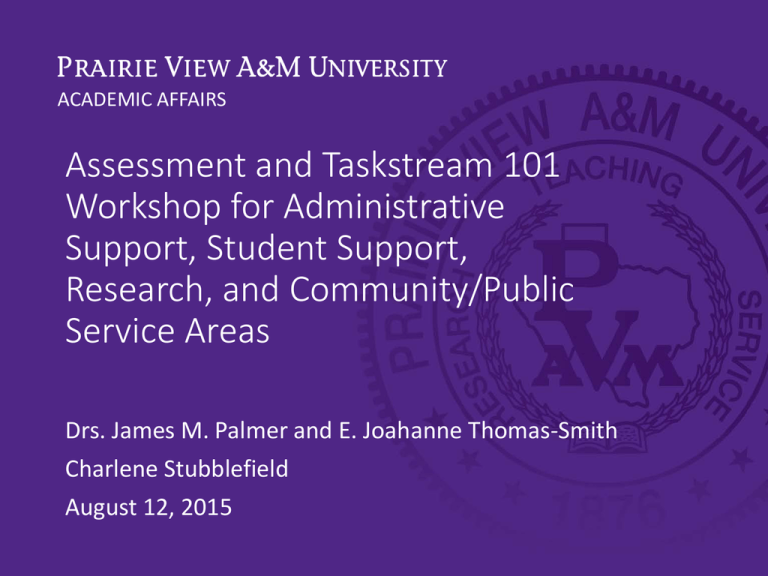
ACADEMIC AFFAIRS Assessment and Taskstream 101 Workshop for Administrative Support, Student Support, Research, and Community/Public Service Areas Drs. James M. Palmer and E. Joahanne Thomas-Smith Charlene Stubblefield August 12, 2015 Workshop Overview SACSCOC 2.5 and 3.3.1 Requirements PVAMU’s Six Question Model Assessment (Plan) Components: mission, outcomes, measures, cycles, targets, use of results Examine Sample Plan/Cycle: From Start to Finish Overview and Demonstration of Taskstream AMS/LAT How Will Areas Represented Use Tasksteam? Designing an Assessment Plan for Tasktream AMS Entry SACSCOC 2.5: Institutional Effectiveness Core Requirement (Institutional Effectiveness): The institution engages in ongoing, integrated, and institution-wide research-based planning and evaluation processes that (1) incorporate a systematic review of institutional mission, goals, and outcomes; (2) result in continuing improvement in institutional quality; and (3) demonstrate the institution is effectively accomplishing its mission. (Institutional Effectiveness) SACSCOC 3.3.1: Institutional Effectiveness Comprehensive Standard 3.3.1 (Institutional Effectiveness): The institution identifies expected outcomes, assesses the extent to which it achieves these outcomes, and provides evidence of improvement based on analysis of the results. 3.3.1.1 educational programs, to include student learning outcomes 3.3.1.2 administrative support services 3.3.1.3 educational support services 3.3.1.4 research within its educational mission, if appropriate 3.3.1.5 community/public service within its educational mission, if appropriate Effectiveness Begins with a Plan Typical Assessment Plans at PVAMU Have Included the Following: I. Unit Mission II. Mission Alignment Statement III. Unit Vision IV. Core Values V. Conceptual Framework VI. Goals VII. Program and/or Student Learning Outcomes VIII. Assessment Cycle of Unit and Data Collection …Execution of Plan… IX. Assessment Reports and Responses to Data Key Definitions Unit Mission – A statement of the purpose, functions and activities of your unit. Your unit's outcomes derive from your mission statement. Mission Alignment – A statement showing how your mission aligns with that of the university. Unit Vision – A statement about what you would like to see your unit become. How will unit evolve? Core Values – A set of values that are clearly defined and aligned to the University’s core values of access and quality; accountability; diversity; leadership; relevance; and social responsibility. Key Definitions Conceptual Framework – A narrative that outlines the foundation—knowledge, skills, and services—on which you are assessing your unit. Typically, the conceptual framework is researched-based. Goals – Broad statements that describe the career and professional accomplishments that the program is preparing graduates to achieve. Unit/Program Outcomes – are statements that describe what the unit hopes to achieve, whether in customer service, personnel expertise, efficiency, fundraising, research, destination, licensure rates, enrollment, career placement, retention, etc. A program outcome is a specific, measurable statement that describes desired performance. Key Definitions Assessment Cycle of Unit and Data Collection –The interval in which your unit will collect data. The assessment cycle indicates when outcomes of all types will be assessed, the measures used to assess them, and target achievement. Direct measures provide for the direct examination or observation of achievement, knowledge or skills: numbers of companies represented at a career fair; percentage of work orders fulfilled; dollar value of grant funds; numbers of events hosted; analysis of a student's assignment, performance, task, etc. Indirect measures assess achievement and learning based on the opinion of a customer or student who judges the value of the experience provided. Surveys, interviews, and focus groups are indirect measures. Examples of additional measures: Assessment Reports and Responses to Data– This is a summary of the data collected and statements (strategies) regarding how the data will be used to improve learning and/or service delivery. PVAMU’s Six-Question Assessment Model Outcome Strategies Means / Measures Cycle Results Use of Results The Fundamentals: What’s Needed in Taskstream for 3.3.1 Compliance? Unit Mission Mission Alignment Outcomes Measures and Cycle … Data Collection and Responding to Data Closing of The Loop: An Example from Start to Closure Always consider the University Mission first. Starting The Loop: An Examination of The Unit Mission Unit Name: Information Resources Unit Mission: Information Resources will assist the university in achieving its first class status in research, teaching, and service by providing efficient and effective information resources, VoIP network and web presence in an impeccable manner [and ensure] compliance with applicable laws, policies, and regulations. What outcomes stem from this mission? Starting The Loop: Outcomes Stem from The Mission Unit Name: Information Resources Unit Mission: Information Resources will assist the university in achieving its first class status in research, teaching, and service by 1) providing efficient and effective information resources, VoIP network and web presence in an impeccable manner [and ensure] 2) compliance with applicable laws, policies, and regulations. Starting the Loop: Establishing Outcomes and Strategies Outcome Clients served will rate responsiveness to requests/client needs with at least an 80% satisfaction rating. Strategies Respond to requests via email, telephone, office visits in a timely fashion. Interact with clients in a friendly and professional manner. Supply relevant and meaningful information regarding their requests. Continuing the Loop: Establishing Measures and Targets What measure(s) would be appropriate for the following outcome: Clients served will rate responsiveness to requests/client needs with at least an 80% satisfaction rating. Direct: Portfolios Licensure exams Exams (standardized / local) Performance appraisals Internships, Clinical Experience Indirect: Exit and other Financial data Student artifacts interviews Audits, Reviews, Complete Surveys and orders questionnaires Behavior observations Job placement data Campus statistics Continuing the Loop: Means/Measures and Cycle Means/Measures Satisfaction Survey Q1, Q2, and Q4 Cycle Survey is administered and results reported yearly. Continuing the Loop: Sample Measure Q1 Means/Measures Continuing the Loop: Results Results Q1 (readily available) 2012 results:76% agree; 24% disagree 2014 results: 79.4 agree; 12.8 disagree; remaining N/A (new option) Q2 (courteous and professional) 2012 results: 94% agree; 6% disagree 2014 results: 84.6%;7.7% disagree, remaining N/A (new option) Q4 (responsive to my needs) 2012 results= 82% agree; 18% disagree 2014 results= 76.9% agree;15.4% disagree; remaining N/A (new option) Closing the Loop: Use of Results (Strategies for Improvement) Use of Results Given results of Q1 and Q4 falling below the 80% target, Information Resources will 1) cross-train Mr. Larry Management to assist with phone and email responses and 2) develop and use a script for incoming calls. The cross training will make more staff available to answer phones and the script will help us to better assess client needs. To further address satisfaction rates, by October 15, we will further 3) update our FAQ page on the web, as mentioned and requested in seven of 39 surveys. The FAQ update will include several questions regarding sign-up for web development training and survey development in Qualtrics. Taskstream: PVAMU’s Assessment System Strategic planning Accreditation preparation General Education assessment Discipline-specific assessment Non-academic assessment Signature, capstone, or key assessments Direct, evidence-based assessments e-Portfolio assessments Performance assessments Creating an Assessment Plan for Entry into Taskstream: A Hands-on Session Best Practices • • • • • Be Transparent – share and discuss residual data Align measures with outcomes Gather data from a variety of sources Be on-going and integrated USE the results. Data-driven units are facilitated by assessment results when making decision regarding strategies for Continuous Quality Improvement. Thanks to Dr. Kay Norman and many others for assistance with a prior version of this presentation. James M. Palmer, E. Joahanne Thomas-Smith, Charlene Stubblefield jmpalmer@pvamu.edu 936-261-2214
